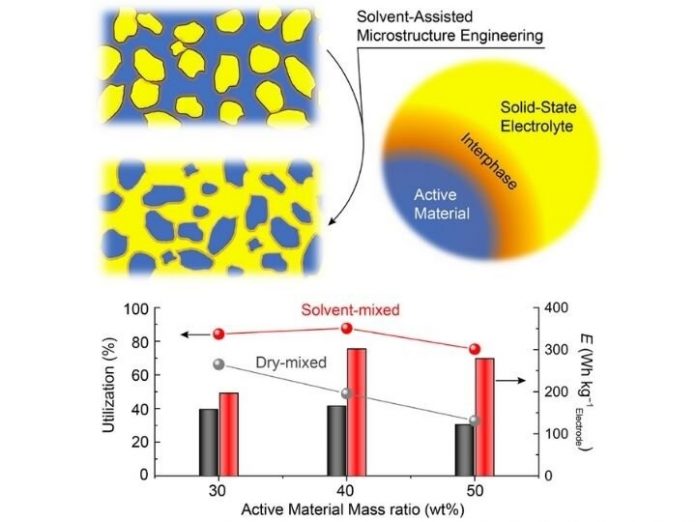Only 2% of vehicles are electrified to date, but that is projected to reach 30% in 2030. A key toward improving the commercialization of electric vehicles (EVs) is to heighten their gravimetric energy density—measured in watt-hours per kilogram—using safer, easily recyclable materials that are abundant. Lithium-metal in anodes is considered the “holy grail” for improving energy density in EV batteries compared to incumbent options like graphite at 240 Wh/kg in the race to reach more competitive energy density at 500 Wh/kg.
Researchers at the University of Houston are taking on this challenge with Rice University colleagues. The team demonstrate a two-fold improvement in energy density for organic-based, solid-state lithium batteries by using a solvent-assisted process to alter the electrode microstructure.
We are developing low-cost, earth-abundant, cobalt-free organic-based cathode materials for a solid-state battery that will no longer require scarce transition metals found in mines,” said the team. “This research is a step forward in increasing EV battery energy density using this more sustainable alternative.
Any battery includes an anode, also known as the negative electrode, and a cathode, also known as the positive electrode, that are separated in a battery by a porous membrane. Lithium ions flow through an ionic conductor—an electrolyte, which allows for the charging and discharging of electrons that generates electricity for, say, a vehicle.
Electrolytes are usually liquid, but that is not necessary—they can also be solid, a relatively new concept. This novelty, combined with a lithium-metal anode, can prevent short-circuiting, improve energy density and enable faster charging.
Cathodes typically determine the capacity and voltage of a battery and are subsequently the most expensive part of batteries due to the usage of scarce materials like cobalt—set to reach a 65,000-ton deficit in 2030. Cobalt-based cathodes are almost exclusively used in solid-state batteries due to their excellent performance; only recently have organic compound-based lithium batteries (OBEM-Li) emerged as a more abundant, cleaner alternative that is more easily recycled.
There is major concern surrounding the supply chain of lithium-ion batteries in the United States. In this work, researchers show the possibility of building high energy-density lithium batteries by replacing transition metal-based cathodes with organic materials obtained from either an oil refinery or biorefinery, both of which the U.S. has the largest capacity in the world.
Cobalt-based cathodes generate 800 Wh/kg of material-level specific energy, or voltage multiplied by capacity, as do OBEM-Li batteries, which was first demonstrated by the team in their earlier publication, but previous OBEM-Li batteries were limited to the low mass fraction of active materials due to non-ideal cathode microstructure. This capped total energy density.
The team uncovered how to improve electrode-level energy density in OBEM-Li batteries by optimizing the cathode microstructure for improved ion transport within the cathode. To do this the microstructure was altered using a familiar solvent—ethanol. The organic cathode used was pyrene-4,5,9,10-tetraone or PTO.
Cobalt-based cathodes are often favored because the microstructure is naturally ideal but forming the ideal microstructure in an organic-based solid-state battery is more challenging.
On an electrode level, the solvent-assisted microstructure increased energy density to 300 Wh/kg compared to the dry-mixed microstructure at just under 180 Wh/kg by improving the utilization rate of active material significantly. Previously, the number of active materials could be increased but the utilization percentage was still low, near 50%.
Over the last ten years, the cost of EV batteries declined to nearly 10% of their original cost, making them commercially viable. So, a lot can happen in a decade. This research is a pivotable step in the process toward more sustainable EVs and a springboard for the next decade of research. At this rate, perhaps just as literally as euphemistically, the future looks much greener on the other side.








